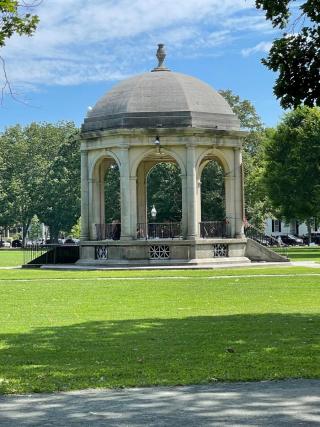Salem Common

The Salem Common is located in the heart of the city and is an over 9-acre open space park in the Salem Common Historic District. It’s Salem’s oldest park, established in 1803 and is host to many community events throughout the year and is used for daily recreation. Salem Common was the site of the First Muster (1637) of the East Regiment, which signaled the start of the National Guard. The Common itself is listed in the National Register of Historic Places and is protected with a preservation restriction.
The Bandstand
The bandstand at the Salem Common was constructed in 1926 in commemoration of the city’s Tercentennial. Philip Horton Smith designed this finely proportioned octagonal bandstand in Colonial Revival style, domed and temple-like. Its roof is capped by a pineapple, and the arches are flanked by an engaged pair of Roman Doric columns. In 1976, the bandstand was dedicated to the longtime Salem Band director, Jean Missud of Salem Cadet Band Fame.
Presentation to the Community
Phase 1 (completed in 2020)
Phase 2 - Next phase coming soon.
The Washington Arch
After relocating the Arch to it's current location the City worked with the Salem Common Neighborhood Association (SCNA) to repaint the Arch, add decorative brick work, new landscaping and an explanatory sign. In April 2023, restoration was completed with the unveiling of the carvings of Washington, the accompanying swags, and the shining golden eagle, at the annual Muster.
The Historic Fence
Since 2012 the City has restored the fence in phases with each phase encompassing a number of sections depending on the cost and funding at the time. The most recent phase, no. 5, was completed in 2021. Additional information on the historic fence can be found here.
Additional Projects
Tree Plantings (2023)
In the spring of 2023 37 new trees were planted in the Common. This project was started in 2022 and was finally completed in 2023 thanks to the efforts of the Friends of the Salem Common and the Tree Commission. Funding for this project was made possible via American Rescue Plan Act (ARPA) Funds, a FY2023 State Earmark and private donors to the Tree Fund resulting in additional Century Trees being able to be planted.

